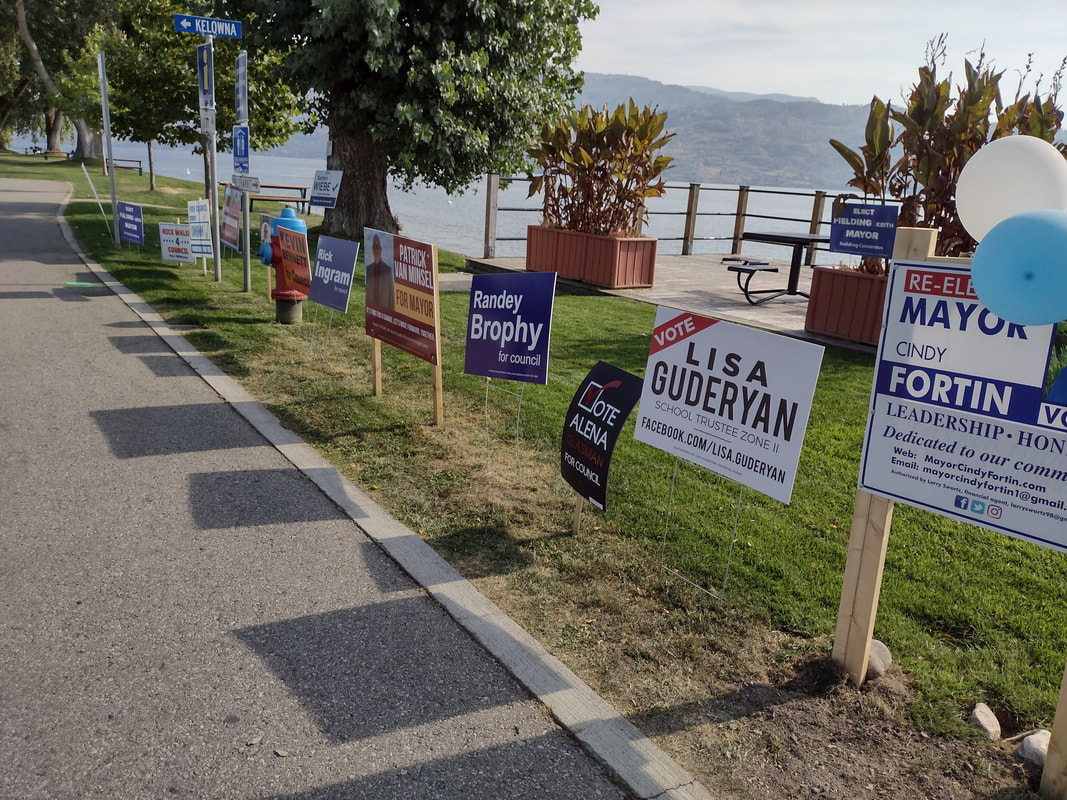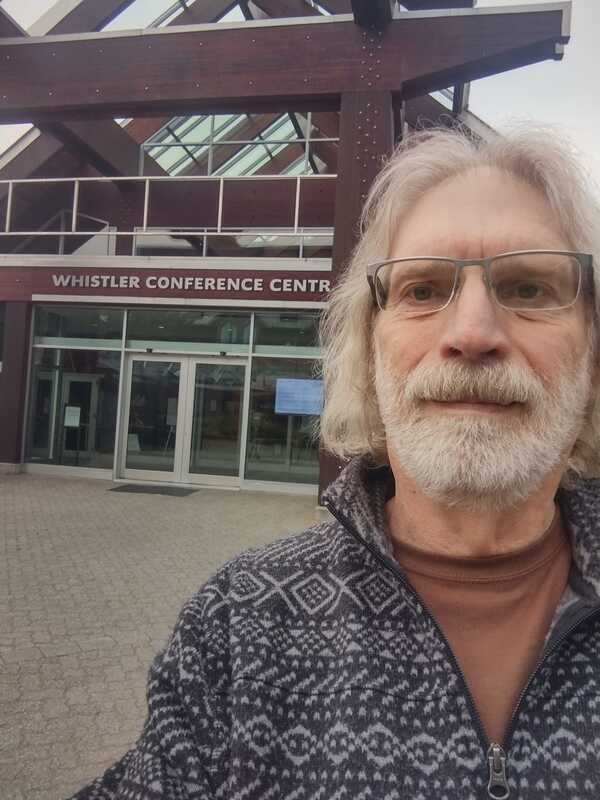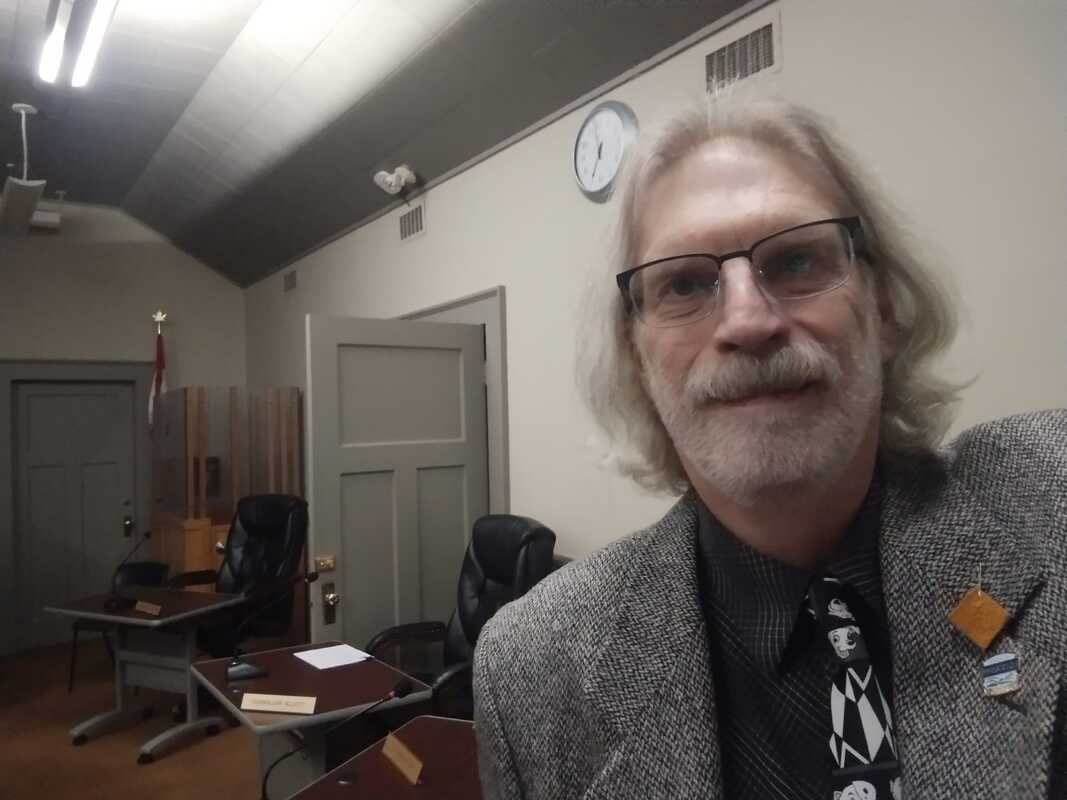|
I was asked the other day why I don’t have election signs covering street corners and intersections. Well, the simple answer is that I’m not interested in contributing to the sign pollution we already face daily. Plus, those signs are not cheap. The last time I priced them (out of curiosity) they were $25+ each. I think that’s too much to spend for the ROI (return on investment). However, both good and bad arguments revolve around election lawn signs.
The Good… According to Vincent Raynauld, election signs “have a great appeal, especially for voters who are shifting away from text-based communication.” Raynauld is an affiliate professor of communication studies at the University of Quebec Trois-Rivieres. He goes on to say that lawn signs are perceived by people as they drive by them, and since they don’t normally have time to slow down and read what is on the election signs they see, the visuals become more important. Raynauld adds, “these visuals tend to speak to people’s emotions…good visuals that are very appealing might push things over the edge and might convince people to go out and vote.” More on visuals in a minute or two. The Bad… Election signs tend to become targets. They get vandalized. They get stolen. I attended a meeting in Kelowna last week with 20 other elected officials representing communities up and down the valley. The topic of election lawn signs came up. One election candidate from the North Okanagan had indicated that her sign budget was getting stretched as she had a total of eight signs stolen over the previous week. Another candidate from the South Okanagan explained that he was recycling signs from his previous election bid from 2018 and had only so many available to use that weren’t defaced. Do Election Lawn Signs Work? According to Mount Royal University (Calgary) political scientist Duane Bratt, they do pay dividends. The research he conducted showed that the more lawn signs a certain candidate has, the higher the voter turnout is. With more voters going to the polling station, the better chance the candidate with the most signs has of getting elected. Bratt explains, “Imagine a person who’s not following the election very closely, and they see lots of signs for one candidate. That becomes a kind of momentum, and they believe that while everyone else seems to like this person, maybe I should vote for them, too.” What Do I Think? Hmmm. Let me see. The current Princeton Town Council contains five elected officials (1 Mayor, and 4 Councillors). Three candidates were running for Mayor and 15 running for Councillor in the 2018 municipal election. Of the current Town Council, two members did not have lawn signs as part of their election campaign. Fast forward to 2022. 8 candidates are running in this municipal election (2 for Mayor, 6 for Councillor). I am the only candidate not using lawn signs as part of my election campaign. I still don’t think lawn signs are going to impact a small-town municipal election. That’s just my opinion. How To Design The Perfect Election Lawn Sign Okay, let’s look at the visuals. Believe it or not, there is a great deal of science behind the design of the perfect election sign. Considering I have 40+ years of experience in media marketing and several years in graphic design, I think I can safely speak on this and offer some valuable insight. Colours The first thing I would decide on is the colour combination I would use on my signs (if I were to purchase any). At the top of my list would be black on yellow. The second would be white on red. Those two choices top my list simply because they are the colour combinations used for traffic signs and we are all programmed to look at signs with those colours. White on green would work, black on white, or white on black. I would steer clear of more than two colours on any election lawn sign. Font The font is the shape of the letters that appear on your sign. I would stick to a sans serif font (a font where the letters do not have fancy edges to them), and choose one with thick enough lettering that it can be read easily from a short to medium distance. I would also stay away from mixing more than two fonts. Content Content is the information that appears on the lawn sign. I am a firm believer in the keep-it-simple rule. On my way to that meeting last week in Kelowna, I saw all kinds of election lawn signs. Of them, I could read only about 10 percent of them. The majority of them were too wordy. I can’t read that much information from a lawn sign as I’m driving by at 100 kph. However, there was one sign design in Peachland that stood out to me. It was a thick font, black on orange. This is what it said: “(Candidate’s name) FOR COUNCIL.” The name was on the top line, the “for Council” below it. That’s all you need on an election sign. You do not need your photo. You do not need to list your qualifications, your platform, your personal information, your contact details, etc. If I had election signs, mine would be black on yellow and all they would say is “GEORGE ELLIOTT FOR COUNCIL.” Short, simple, and to the point. *Elections BC requires signs to include a short line that says "Authorized by (name, phone number)" but it can be very, very small. How Do I Know It Will Work? I’m a freelance writer. I used a short black-on-yellow message in the advertising of my writing service on a freelance platform I use. It was the only one like that and stood out in searches on that website. It stood out so much, that I was getting hired frequently for writing jobs. The number of jobs I received increased when I changed my marketing visuals to black-on-yellow. They have since dropped as I have changed the visuals again to a more information-based approach. I know the problem, too many words, and too much clutter. I may resurrect the black-on-yellow ad posts once again. Location Probably one of the most crucial aspects of election lawn sign use is where you put your signs. Elections BC has some guidelines on where they can’t be posted, but where will you get the best ROI for your signs? Here are some places I would use: Princeton Landfill A friend of mine suggested placing an election sign at the entrance to the landfill site. Since it’s municipal property, you shouldn’t post anything there, but I will modify my friend’s idea. I would post a sign opposite the landfill site facing it so that as you drive out of the landfill site and stop to enter Princeton-Summerland Road, you see the sign looking right at you. KVR I’ve already seen signs on the trail that cuts through town. I would post signs along there as the majority of people using that route are following the posted speed limit of 30 kph, if they are not on foot, and reading an election sign there would be easier with less distraction from other posters or signs. Any “T” Intersection Several places around town have what I would consider a “T” intersection. The best thing about these intersections is that you can’t miss something facing you as you enter the intersection before turning left or right. Corner Residential Lots There are neighbourhoods around town with a significant amount of foot traffic. Once you can identify such a location, see if you will be permitted to post your sign on the lawn of the home at the corner of one of these streets. Face the sign in the direction where foot traffic can see and read it as they approach the corner. In Conclusion Election lawn signs do serve a purpose provided they are designed correctly and placed in the right location. One thing is for sure, although you won't see my name on election lawn signs, you will find it on your election ballot. On October 15, please cast a vote for me, George Elliott. -- Article Source: CBC News September 2021
0 Comments
Let’s get this out of the way right now. No one intends to get elected to Town Council for fame and fortune. That was most certainly not my goal when I tossed my hat in the ring in 1999 and again in 2018 when I finally did get elected.
I wanted to get involved for various other reasons. Primarily, I thought it would be great to be part of a team that pushed Princeton into the future. I never really thought of myself as a single voice around the council table. Instead, I view myself as a part of the machine that drives the community forward. Sure, I have opinions, attitudes, points of view, disagreements, etc. I have voted against some motions made during meetings. I think that’s all a normal part of the process. But Don’t We Make A Bundle Spending Taxpayer's Money? Absolutely not. I receive remuneration monthly. It totals $1,037.63 (gross) with $42.52 going to CPP leaving $995.11 (net) each month. Sure, I have an expense account that covers convention fees. As for extras, I only claim for my mileage and not the permitted food allowance simply because I figure I’m going to be eating anyway, so I’ll cover those costs. Regardless, it’s not a lot of dough and I’m okay with that. What Others Are Making In Local Government I did a quick survey of a few other communities for comparison. Councillors at the Town of Osoyoos earn (rounding up/down) $1,585 per month. In Penticton, Councillors earn $2,225 monthly. In Merritt, it’s $1,500 per month for a Councillor. So, as you can see, fame and fortune are not part of the incentive to seek election. Speaking of Fame… I can’t forget to explain that (as you can imagine) I sometimes feel like I have a target on my back. I spend numerous hours monthly on Town Council business. If it’s not preparing for a meeting or attending one, I’m at one of several committee meetings that are part of my council appointments. Then I try to attend some public functions. It doesn’t always work out as I’m also juggling my home-based business and the commitments that come from that. Oh, and there’s the social media activity. Usually, I get a few private messages when I’m not ‘tagged’ in posts. I get stopped downtown while conducting personal business to discuss issues. The odd time someone will show up at my door. I get emails. I get phone calls. I’m expected to have all the answers, which is impossible. I’m also fortunate in that I probably get fewer interruptions than anyone else on Town Council. It Comes With The Territory By the way, I don’t consider any of the contact people make with me as interruptions. To be honest with you, I quite enjoy the interaction and meeting some people I don't already know. I try to make myself accessible so I can be reached. I figure that's the least I can do as I am considered a public official. I used to have my social media feeds locked down tight but decided that just shuts me off of the people I’m supposed to represent at the council table. But I do think the community is getting a pretty good deal from me, for just $995.11 (net) a month. If you think the same thing, please remember to vote for me, George Elliott, on October 15. Thank you! The math says so. The success rate of incumbents in Canadian municipal elections is higher than that in any other democratic country. The percentage is also greater than that in both provincial and federal elections. This is according to University of Calgary associate professor Jack Lucas who is part of UC’s department of political science.
“It’s often the case that above 80 percent - and sometimes above 90 percent - of the incumbents who choose to seek re-election in Canadian cities are successfully elected to office,” Lucas says. He adds, “There's an enormous success rate.” There Are A Few Reasons Why This Happens Lucas claims that re-election success comes from a few factors. They include:
Let’s dig a bit deeper into these reasons. Name recognition makes sense as residents become used to hearing that Councillor George Elliott did this or said that. The name sticks in their minds over the four-year term and they remember it when they see it on a ballot. As for the prizefighter hypothesis, Lucas says that essentially, this is the same thing as a good, strong football team that keeps winning games. Some candidates just have those qualities that resonate with voters. Maybe they are approachable. Maybe they are more visible. Whatever it is that voters take a shine to will impact that candidate's success rate. The office holder benefit is when someone is already in office, they are perceived to have an advantage. Lucas explains it this way: “Voters assume, for example, ‘Well, this person has won in the past and so they must not be that bad. So I’ll give them the benefit of the doubt and vote for them again.'” The last point, incumbent satisfaction, is self-explanatory. If you are happy with the job the incumbents have done to this point, then why change things, right? That is incumbent satisfaction. There Are Ways To Beat Incumbent Advantage Here’s the other side of the coin. There are two main ways that incumbency advantage can be broken. That is according to Lucas and Jim Nicol. Nicol is the city clerk for the City of Regina and was the returning officer for that city’s 2020 municipal election. Both say that online information and a party system in municipal elections can derail incumbency. Lucas says that the more information a challenger has online that is easy to access, the more likely voters will consider them as possible choices. Nicol nods to the concept of a party system for local elections similar to that used in Vancouver. Lucas agrees to say that voters may be able to track what candidates say easier if they belong to a slate of candidates. Voter Turnout Also A Key Lucas adds that more research is needed on this particular topic, but he firmly believes that the incumbency advantage can be impacted by voter turnout. It makes sense. If local voters figure they don’t need to cast ballots because they assume all the incumbents will win anyway, those voters who do go to the polls will have more say as only their votes will count. If the majority of these voters do not support the incumbents because they want change, then change is likely to happen. Princeton’s Election Cycle With all of this data, it still makes me shake my head that the 2018 Municipal Election saw not a single incumbent re-elected to Princeton Town Council. Granted, there were a lot of candidates running for the five seats (18 in total). In this election, all five incumbents are running with a total of three challengers (1 mayoral candidate, and 2 councillor candidates). On October 15, 2022, remember that your vote still counts. I’d be happy if you considered casting one for me. I’m George Elliott. I’m an incumbent seeking re-election to Town Council. -- Article Source: CBC News November 2020 |
Details
AuthorMy name is George Elliott. I have been in the Media Industry since 1978. I spent 23 years in Broadcasting and worked in a total of six different radio stations located in southern British Columbia Canada during my career. In 2000 I switched gears and moved into the Print Media Industry at a small town, local weekly community newspaper. In 2004 I bought the paper and operated it with my wife, Brenda until July 2016 when we closed it. I launched a freelance web content and article writing business from my home in January 2014. Archives
October 2023
|



 RSS Feed
RSS Feed
